Get the best from a foam roller: exercises for cyclists
Foam rolling can aid recovery and stave off injury, we outline what muscle groups to focus on and how to ensure you’re reaping the benefits
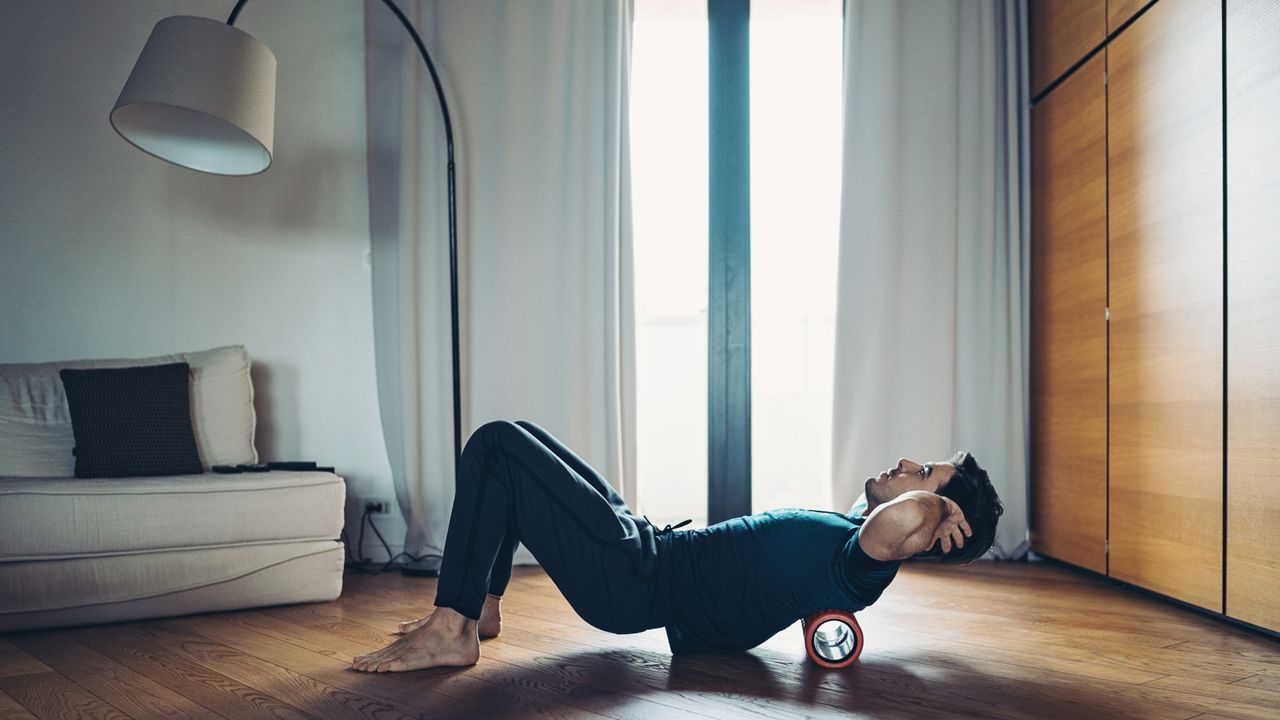
Foam rollers are advocated by many physiotherapists and other health care professionals for a variety of reasons - to reduce muscle pain, improve range of motion (ROM) and flexibility, for athletic performance, recovery, and injury prevention.
Using one of these cylindrical, pain inducing gadgets has certainly become very popular in recent years and the foam roller is now an established form of self-massage or self-manual therapy.
The ultimate form of myofascial release is of course a professional sports massage where the therapist can use their knowledge to identify problem areas and use a variety of different techniques to treat them, avoiding potential cycling injuries. However, many of us do not have the time or money for regular sports massages, so foam rolling is an easy, practical, cost-effective alternative.
What is foam rolling?
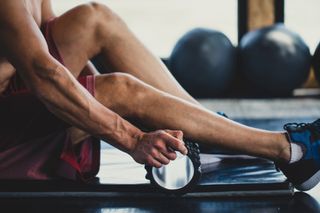
Foam rolling is a form of myofascial release which uses a cylindrical gadget made of, or covered, by foam. Your bodyweight is used to apply pressure to the soft tissues during a rolling motion.
Myofascia is a thin, strong, dense, fibrous connective tissue that surrounds our muscles, bones, organs, nerves and blood vessels of the body. “Myo” refers to the muscle, and “fascia” the connective tissue.
It gives structural support to our bodies, prevents friction between tissues, and transfers force from our muscles to our bones. Fascia is a sensitive structure containing nerve endings and mechanoreceptors (movement sensors), and hence plays a role in posture, movement coordination and proprioception.
You’ll find that myofascia can become tight and adhere together in response to repetitive movement, habitual postures, and trauma. By freeing up the fascia, the surrounding muscle will regain its movement and function, and you’ll be able to perform better on the bike.
Get The Leadout Newsletter
The latest race content, interviews, features, reviews and expert buying guides, direct to your inbox!
Choosing a foam roller
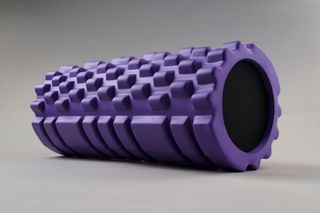
There are a number of foam rollers available on the market, with variations in size and density, whether they vibrate or have bumps, foam rolling sticks, and of course price.
A standard foam roller is 15cm in diameter, and models range from 30cm long for easy storing and portability when travelling, to those that are 90cm long which will give you the opportunity to use it on the full length of your back should you wish to. Most people are fine with a medium density roller, although those who are well-acquainted with soft tissue therapy may prefer a firmer product.
There are also knobbly foam rollers out there with bumps along the surface that are designed to provide additional trigger point massage. These often have a hard plastic core, with foam over the top. They are generally a bit more durable, but also more expensive and most people get on fine with a basic foam version.
How to use a foam roller
The main areas that typically require attention in cyclists are those that produce the most power, namely the quads and glutes. That said, the hamstrings and calves also contribute to the pedal stroke, and the hip flexors and upper back are chronically in a flexed position, so these muscle groups should also be addressed.
Never roll over bony prominences or tendons as this can cause irritation and inflammation of these areas. Instead you should be aiming for the muscle belly.
Slowly does it. The movement should be a long smooth and progressive push rather than quickly rolling up and down.
Ready to give it a go? Here are the key areas that you need to focus on and how to go about foam rolling each muscle group effectively.
Quads
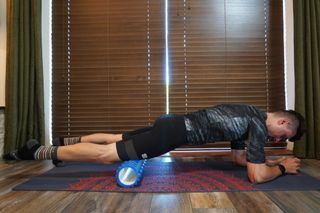
The quads are the main muscle group targeted by cyclists when foam rolling as they produce the majority of power when cycling and are prone to becoming tight and fatigued, hence why foam rolling can often hurt so much.
Lie on your front with the foam roller above the knee and roll up and down the outside, front and inside of your thigh, focusing on any spots which are particularly tight or painful.
Do not roll over your knee joint, nor over the bone on the outside or front of your hip.
Glutes
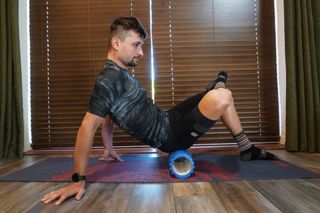
The glutes also contribute significantly to the power delivered to the pedal stroke as well as stabilising the pelvis and leg.
Sit on the roller and cross your leg into a figure-four position by putting one ankle on the top of the opposite knee. Lean to the side of the leg that is on top and roll up and down along the glut.
Be sure to address both the glute max and glute med (more to the outside of your hip).
Avoid rolling over the bony areas of your pelvis or the outside of your hip.
Hamstrings
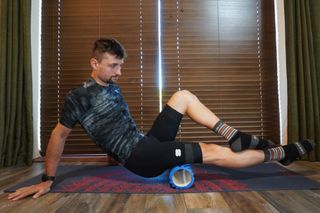
The back of the legs are a more difficulty area to foam roll as often we are unable to apply sufficient pressure. Some people find a roller stick easier to use and more effective for this area.
Put the roller behind your knee and cross one leg over the other to apply more pressure. Lift your body and roll the roller up the back of your leg up to your glutes.
Calves
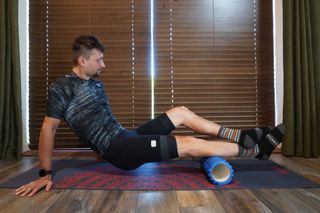
Similarly to the hamstrings, sit with your legs on the foam roller and cross one leg over the other.
Lift your body and roll up and down the calf muscle, twisting your leg inwards and outwards to work on the different parts of the muscle.
Avoid rolling over the back of your knee or your achilles tendon, stay on the fleshy part of the calf muscle.
Hip flexors
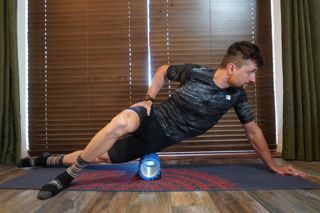
The main muscle to release is your tensor fascia lata (TFL) which is found at the front and side of your hip. It attaches directly to the ITB and tightness will increase the tension of the ITB.
Lie on your side (and slightly to the front) with the foam roller over your ‘pocket’, rolling over this area. The muscle is small (about the size of your hand or pocket) so be sure to keep the range small and not to roll onto the bone at the front of your hip or side where the muscle attaches. Some people find a foam roller is not firm enough and prefer to use a trigger point ball.
Upper back
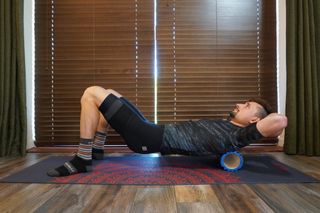
Many cyclists are not only hunched over their bikes for hours at a time, but also their desks in everyday life, resulting in stiffness of their thoracic spine and pain in their upper back.
Lie with a foam roller under your upper back, supporting your head with your hands. Extend over the roll keeping the ribs down. Move up and down the upper back, stopping and stretching over different parts of the spine (upper, mid, lower).
FAQ: Should I foam roll my ITB?
In a word, no. The iliotibial band (ITB) is not a muscle, it is a thick dense band of connective tissue. It has very high tensile strength and transfers contractile force rather than contracting itself.
Therefore you should release the muscles that attach to the ITB that give it it’s tension, most importantly the TFL, but also the glute max and glute med, and the outside quads (although they have only a small attachment near the knee).
How much foam rolling should you do?
Although there isn’t a consensus on what an optimal foam rolling intervention entails. A review paper in 2019 recommended using a firmer type of roller, with the maximum tolerable force for a period of 30 to120 seconds, the movement of each pass should last about three seconds.
During the course of one session, repeat one to three times, separated by a 30-second break. Whilst it is yet to determine if this is optimal, it is practical for amateur riders to follow.
The best approach to take is to have a regular routine that covers all the tight muscle groups that cyclists tend to suffer from. As explained above, that’s the quads, glutes, hamstrings, calves, hip flexors and upper back - it'll take about 10 minutes running through all of those, and you should aim to complete the full set once a day,
If you're going to release one area, it's really a very good idea to provide the same treatment elsewhere to ensure you stay well balanced.
If you're suffering from a specific pain, such as knee pain, it's also important to remember that the bit that hurts isn't necessarily the cause. Rolling over a sore spot isn't the answer - instead you often need to release the surrounding area.
Another common issue experienced by many is pain in the lower back. If you are suffering from that specifically, you might want to check out our in-depth guide to everything you need to know about lower back pain.
Does foam rolling work?
So, what's the evidence that backs the effectiveness of this process?
For starters, there have been a variety of proposed mechanisms and theories on how foam rolling works: mechanical, physiological, neurological and psychophysiological.
There has also been an increase in the number of studies investigating the effects of foam rolling and how it should be done in recent years. Whilst the results suggest some benefit, there are not enough high-quality and well-designed studies on foam rolling to draw any definite conclusions, therefore it is currently not fully supported by scientific evidence.
A number of systematic reviews (which combine the results of a number of studies) have shown an acute and temporary increase in range of motion (ROM) with foam rolling. Many of the studies have used foam rolling as a warm up activity, and have also looked at the effect on performance.
A recent systematic review in 2021 investigated the effect of foam rolling combined with stretching. It found that they both increased ROM, but foam rolling also increased the performance markers of strength or power/jumping. It is now widely accepted that static stretching, whilst increasing ROM, may also decrease performance and strength markers, so foam rolling could be a good alternative to stretching to increase ROM, especially before exercise.
Studies have also looked at the effect of foam rolling on recovery from exercise. A number of studies and reviews have shown that foam rolling post-exercise decreases muscle soreness (DOMS), whilst some also show an increase in performance markers. The absence of any side-effects suggests that it is a worthwhile recovery tool, especially when consecutive days of training or competition are required.
At present, there does not seem to be any studies that directly look at whether foam rolling prevents injury, just what the effects of foam rolling are.
As is often the case, we see a difference between the available scientific and anecdotal evidence, although it appears that more scientific evidence is emerging as further studies are being carried out in this area.
If you're looking to pick up a foam roller to start reaping these benefits, you might find some among the best Black Friday bike deals.

Thank you for reading 20 articles this month* Join now for unlimited access
Enjoy your first month for just £1 / $1 / €1
*Read 5 free articles per month without a subscription

Join now for unlimited access
Try first month for just £1 / $1 / €1
Nicole Oh is a physiotherapist and bike fitter, with training in biomechanical assessments, sports injury rehabilitation, acupuncture and clinical pilates.
A competitive cyclist with a background in triathlon, Nicole raced at National level in the UK, also managing and co-founding the Les Filles Racing Team. Having moved to Sydney, she works as a physiotherapist at The Body Mechanic and continues to race competitively.
-
 Giro d'Italia 2025 route: white roads, twin time trials and a huge final week await in May
Giro d'Italia 2025 route: white roads, twin time trials and a huge final week await in MayThe three-day Albanian start could shape things early, too
By James Shrubsall Published
-
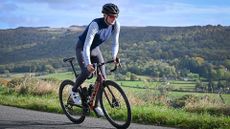 Cervelo Caledonia-5 review: a bike for every occasion
Cervelo Caledonia-5 review: a bike for every occasionSummer, winter, rough or smooth, the Caledonia-5 is an extremely capable bike that sacrifices little in the way of performance
By Tim Russon Published
-
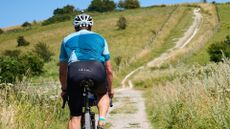 'My riding companion proceeded to fragment into countless tiny particles and dissolve into the night sky — I was hallucinating': Inside a 500km ultra ride
'My riding companion proceeded to fragment into countless tiny particles and dissolve into the night sky — I was hallucinating': Inside a 500km ultra rideKeen to test the limits of his well-matured endurance, Steve Shrubsall hurls himself headlong into a 500km ultra-endurance adventure across England's North and South Downs
By Stephen Shrubsall Published
-
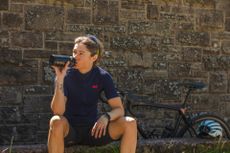 Hot weather cycling: 6 tips to help you keep your cool
Hot weather cycling: 6 tips to help you keep your coolA spell of hot weather needn't stop you enjoying your riding, as long as you take some precautions to prevent over-heating and dehydration
By Anna Marie Abram Published
-
 21 ways to get your season off to a flying start
21 ways to get your season off to a flying startMotivation is key: achievable, aspirational goals with clear checkpoints is a great place to start. Structured training, bike servicing and joining a club will all help set you on the right trajectory, too
By Charlie Allenby Published
-
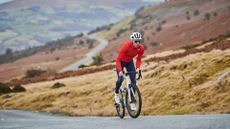 Eight-step guide to crafting your achievable goal this year, according to a cycling coach
Eight-step guide to crafting your achievable goal this year, according to a cycling coachHow to come up with a target you can hit - plus some pointers on how to stay on track
By Chris Marshall-Bell Published
-
 Why is everyone talking about Zone 2 training? Tadej Pogačar, or rather his coach, is responsible - here’s why
Why is everyone talking about Zone 2 training? Tadej Pogačar, or rather his coach, is responsible - here’s whyThe cacophony of praise for Zone 2 training of late left Chris Sidwells scratching his head. So he decided to find out what all the fuss was about
By Chris Sidwells Published
-
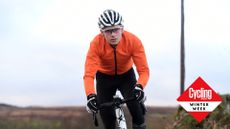 Seven benefits of riding outdoors - which you’ll miss out on if you train inside all winter
Seven benefits of riding outdoors - which you’ll miss out on if you train inside all winterAs with most things in life, there is a balance to be struck…
By Andy Turner Published
-
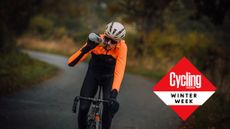 Winter fueling: how to match your cycling nutrition to the demands of cold weather riding
Winter fueling: how to match your cycling nutrition to the demands of cold weather ridingGetting the most out of your winter training means making sure you are optimally fuelled for every ride - here's what you need to know about the specific demands of cold season nutrition
By Joe Laverick Published
-
 Suffering from numb feet or hands when cycling? Here's how to combat the cold
Suffering from numb feet or hands when cycling? Here's how to combat the coldYour extremities are the first to suffer when the temperture drops. Here's how to avoid painfully cold hands and feet
By Hannah Bussey Published